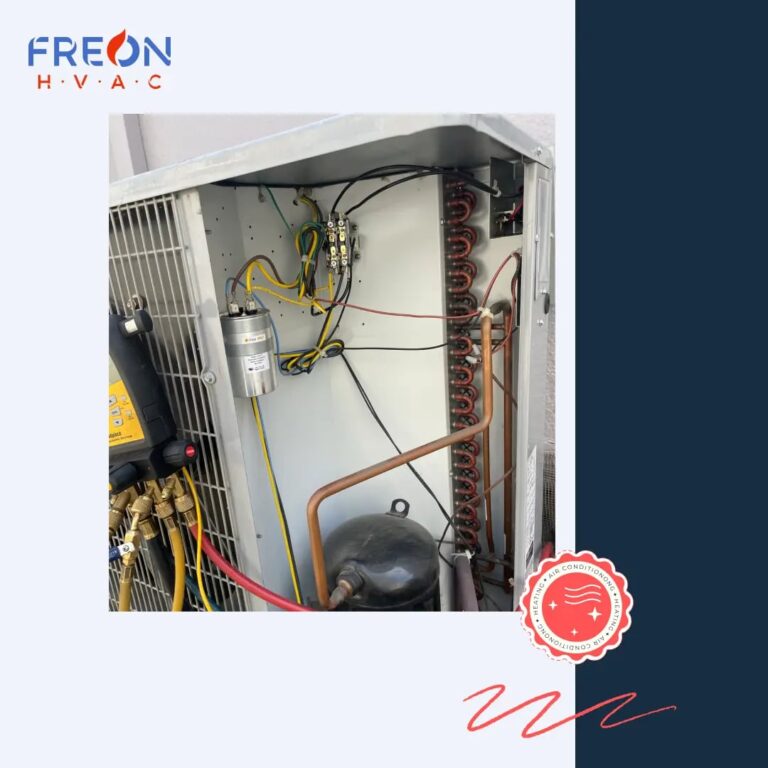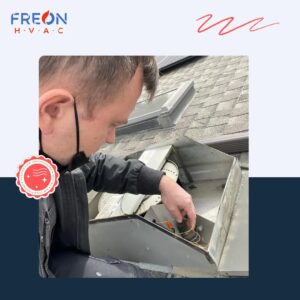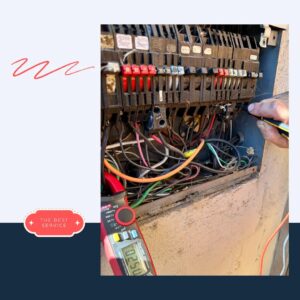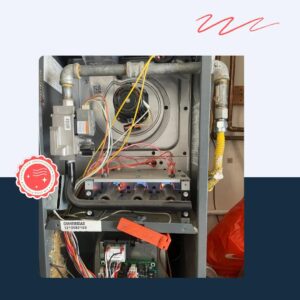Most Efficient Air Conditioner in San Jose: How to Choose

This purchase is not just a question of “cools/doesn’t cool.” In our city, where summer temperatures often exceed 90°F and electricity bills can bite, precise efficiency ratings matter. In this article, Freon Service will explain how these parameters affect costs, comfort, and system longevity.
Most Efficient Air Conditioner and Its SEER
The efficiency of each “cooling machine” is measured by several key indicators. One of them is the Seasonal Energy Efficiency Ratio:
- SEER is the ratio of the total cooling output produced over a season to the energy consumed.
- The number following this abbreviation indicates how efficiently the AC cools throughout the season, taking into account different temperatures and operating modes.
- For example, SEER 16 means the system produces 16 units of cooling for every unit of energy consumed.
Can we logically conclude that the most efficient AC unit, and the higher its SEER, the better?
- Definitely, the higher this rating, the more economical your cooling system and the lower your electricity bills.
- With SEER 20, for the same cooling, you would use almost half the energy compared to SEER 10.
However, saying that higher is always “better” and that everyone should aim for the maximum number oversimplifies the situation. In reality, it looks like this:
- Minimum – SEER 14
- Sweet spot – SEER 18–20
- Overkill – 22+
Why? Brace yourself for a surprising insight…
- First, higher-SEER models are more expensive. In San Jose, where summer temperatures often reach around 90–95°F, investing in SEER 18–20 can pay off faster than in cooler regions. But if you live in a small apartment and only occasionally run your cooling unit, such an extra cost isn’t always justified.
- Second, efficiency strongly depends on climate. Our region has hot summers and mild winters. Here, the most efficient ac system operates not only for cooling but sometimes also for heating. Therefore, the balance between SEER (cooling) and HSPF (heating efficiency) is especially important. For houses in Santa Clara Valley, a reasonable minimum is SEER 16, while for two-story homes or larger spaces, SEER 18–20 is more appropriate.
- Third, it’s important to consider home size and proper installation. Among Freon Service clients, many own houses with large windows and glass doors. This increases heat load, and a SEER 14 unit will be working “flat out.” In contrast, a condo in downtown San Jose or near the San Jose State campus will do fine with a compact SEER 15–16 system.
Conclusion: For San Jose, the minimum reasonable standard is SEER 16, and the optimal choice for larger homes is SEER 18–20. Higher numbers are justified only for heavy usage or if you want to maximize bill savings.
Most Efficient AC System and EER
The Energy Efficiency Ratio shows instantaneous efficiency under specific standard conditions—namely, outdoor temperature and humidity.
Why is this important?
- To compare models with each other
- To estimate energy consumption under peak conditions
Here’s how it works: if two units have the same SEER but one has a higher EER, it will perform better in extreme heat.
This indicator is especially critical in hot regions where even the most efficient ac unit often runs near maximum. Such areas include Texas, Arizona, and the Middle East.
What about San Jose?
- First, a high EER, e.g., 12 or above, is still useful: the system works at full power during the day, which is when most electricity costs are generated.
- Second, in San Jose, your “heat rescuer” often doesn’t need to run 24/7. Thanks to evening breezes and relatively cool nights, system load drops. Therefore, EER is less critical here than in Phoenix or Dallas.
What’s the summary? If you live in a downtown apartment and use AC intermittently—EER 10–11 is enough. For a spacious house with large glass windows, EER 12+ makes a real difference during peak heat hours.
Most Energy Efficient Air Conditioner and Energy Star
This label indicates that the device has passed independent EPA certification for energy savings and meets high efficiency standards.
Why does it matter?
- It guarantees that your room cooler consumes 10–30% less energy compared to standard models.
- In some cases, it also enables eligibility for tax incentives or rebates.
Of course, to earn Energy Star, the unit must have SEER and EER above the market average.
Most Efficient Air Conditioner: Inverter vs. Non-Inverter
Many Freon Service clients ask: is an inverter compressor standard or optional?
Our answer: in the U.S., such models are becoming the norm, but fixed-capacity units are still available.
Is it worth paying $500–$800 more for the same power class? Let’s look closer at the difference:
- Non-Inverter
- Operates on an on/off principle.
- It starts at full power, then shuts off completely once the set temperature is reached.
- This leads to temperature swings, noise, and sharp peak loads on the electrical system.
- The most energy efficient AC unit with Inverter
- Can smoothly adjust speed and power.
- Instead of repeated restarts, it slows down.
- It maintains a stable cooling baseline.
How does it perform in terms of energy savings?
- Even with the same SEER and EER, the difference is noticeable.
- Inverter units can save 30–40% electricity compared to traditional on/off models. This is because the compressor doesn’t waste energy on starts and avoids overcooling.
- Additionally, lifespan is longer—less wear due to gentle operation.
Best Energy Efficient Air Conditioner: Which to Choose for San Jose?
Everything we’ve discussed—SEER, EER, Energy Star, inverter technology—is important in theory. But how does it apply in practice in San Jose, where the climate is mild, electricity is expensive, and buildings vary widely? Here’s a practical guide:
- Downtown Apartment
- Optimal: SEER 15–16, EER 10–11, compact inverter unit.
- Why: AC is used intermittently, evenings are cooler.
- Benefits: Quiet operation, space-saving, Energy Star = lower PG&E bills.
- House or Townhouse in Evergreen / Willow Glen
- Optimal: SEER 18–20, EER 11–12, inverter required.
- Why: Large windows, sun exposure, multiple living rooms. AC runs almost daily in summer and sometimes in heating mode in winter.
- Benefits: Balanced cooling and heating (SEER + HSPF), fast ROI through energy savings.
With Freon Service, you can be confident that your most energy efficient air conditioner will be chosen for your needs, installed correctly, and optimized for your home—ensuring long-lasting performance for your comfort and health.






